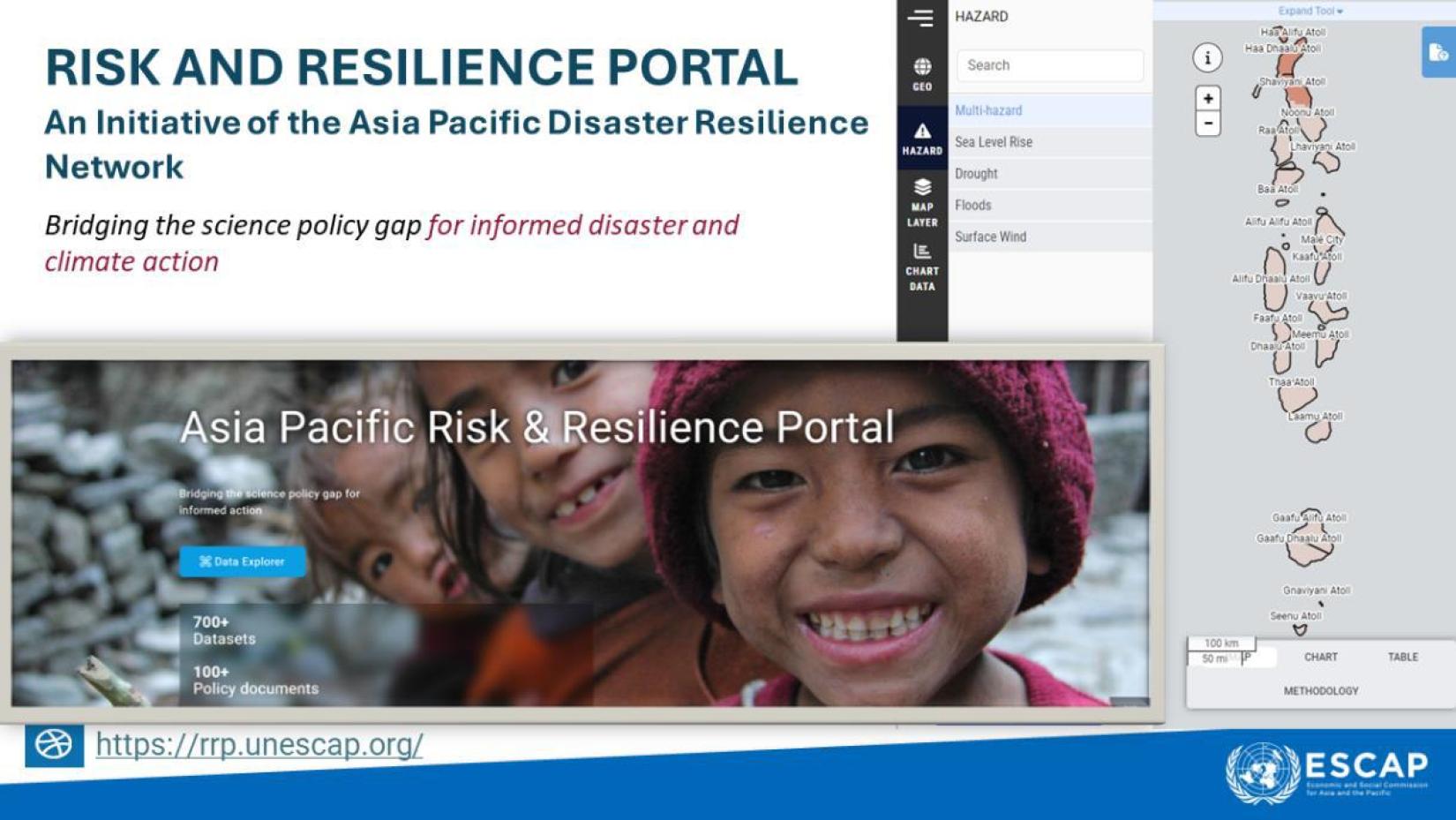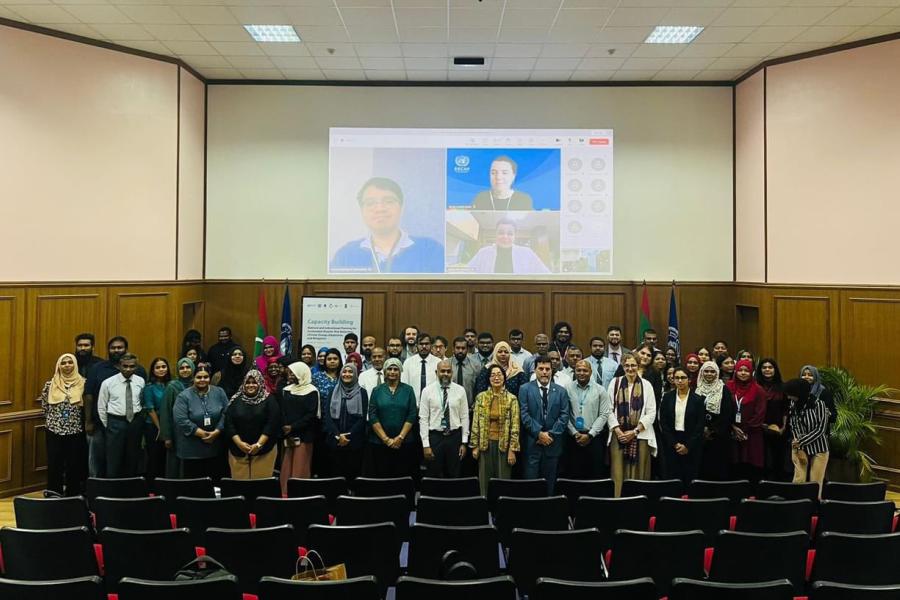Building Resilience in the Face of Climate Change: Empowering Communities in the Maldives
Building Resilience in the Face of Climate Change: Empowering Communities in the Maldives
The Maldives, as a Small Island Developing State (SIDS), is deeply intertwined with the surrounding ocean, influencing both its way of life and its obstacles. While the country flourishes by enticing visitors to its stunning azure waters, the nation grapples with a myriad of climate-related adversities, exacerbated by its low-lying terrain and susceptibility to rising sea levels. With over 80% of its Islands resting barely a meter above sea level, the Maldives stands prominently on the frontline of climate-driven crises, contending with flooding, storm surges, and various other natural hazards. The alterations in weather patterns have notably intensified precipitation, thereby heightening the risk of flooding, particularly in low-lying areas presenting an ongoing peril to the inhabitants.
Considering the current situation and well as the climate projections, in countries like Maldives, disaster risk resilience is essential to the communities to helps people prepare for disasters both in adaptation and mitigation attempts. Recognizing the critical need for action, the United Nations Economic and Social Commission for Asia and the Pacific (ESCAP) and the United Nations Development Programme (UNDP) in partnership with various national stakeholders have joined forces in a collaborative effort to bolster the Maldives' resilience against climate-related hazards while the country is dedicated to enhancing its resilience against climate-related hazards.
As a part of this project in Maldives, a 3-day capacity building workshop on “National and Subnational Planning for Sustainable Disaster Risk Reduction, Climate Adaptation, and Mitigation” was held in Maldives on Jan 30-Feb 1, 2024, in hybrid mode in Malé City, as a collaboration between United Nations Economic and Social Commission for Asia and the Pacific (ESCAP) and Maldives National University (MNU)
Just weeks before this workshop, in between the end of December 2023, to the second week of January 2024 several off-season relentless heavy rains swept through the Maldives, causing flood, extensive damage to crop in some islands and challenges for
The capital city Malé and its suburban extensions, Hulhumalé and Hulhulé were affected by widespread flooding. In Male, many areas of the island were under 1 foot of flood water. Rainfall on December 31st was marked as the highest rainfall ever recorded in Hulhulé's recent history. The aftermath was grim, with 140 homes damaged by water infiltration, ground saturation, and leakage, leaving families devastated and communities reeling. Many parts of the airport were flooded which disrupted the flight schedules.
This is not an isolated incident. The irregularities of weather and climate poses significant challenges for the remote northern and southern islands of the Maldives, extending beyond Male'. In October 2023, heavy rainfall caused floods in the northern islands of Haa Alif and Haa Dhaal Atoll, prompting precautionary warnings from the Maldives National Disaster Management Authority (NDMA). In 2022, the Maldives faced a total of 128 incidents across 19 atolls, with surges being the most common hazard, followed by floods and strong winds. Surges were particularly prevalent in July, while floods peaked in May. Among all incidents, surges had the most significant impact on households, with Thaa atoll reporting the highest number of cases. In 2021, Haa Alif Hoarafushi Airport also bore the brunt of the heavy rain, experiencing huge damages to its infrastructure.
According to the testimonial of an inhabitant from Hulhumale, the weather patterns in the Maldives have undergone significant alterations. Previously, June and July were characterized by the onset of the rainy and windy season, accompanied by rough seas. However, in recent times, even during the month of December or January, adverse weather conditions have been observed, marked by heavy rainfall across the country, leading to widespread flooding. Additionally, there has been a notable increase in the frequency and intensity of tidal surges.
“The unpredictability of weather events has become pronounced, with heavy rain occurring unexpectedly, resulting in flooding on several islands and adversely impacting the livelihoods of the populace” Resident of Hulhumale
According to NDMA, identifying and categorizing hazards like cyclones, tsunamis, flooding, and coastal erosion has been a challenge in Maldives due to the interconnected nature and varied impacts. Additionally, ensuring data privacy and security while making information accessible for research and policy purposes requires a balance to protect sensitive data effectively.
To fill the gap, as part of SDG funded joint project ESCAP has developed the current and future risk profile of Maldives for different climate hazards based on climate projection information and shared the results with the stakeholders from across the sectors during the workshop. The study not only reflects “what the climate will be” but also “what the climate will do” by integrating sectoral information with the possible change in climate in the upcoming days.
According to the results, the central atolls of Maldives which were affected by the recent flooding are more likely to receive high rainfall in future. Many islands in this area have already experienced rainwater related floods in the past. The flooded areas in Male and Hulhule which are identified by low-lying area (with elevation <=1 m) in the study, were under water during the recent flood.
Climate change poses significant socio-economic and cultural challenges for the Maldives, impacting all sectors of the economy. The communities in the islands heavily rely on agriculture, fisheries, and tourism, all of which are directly affected by shifting weather patterns and rising sea levels. After Male’, among the other atolls, the top five atolls with highest percentage of exposed population are Thaa (4%), Kaafu (4%), Alifu Dhaalu (2%), Shaviyani (1%) and Dhaalu atoll (1%). Moreover, 28% of the critical infrastructures such as health, education, water management and government buildings of the country are exposed to high rainfall and many of them are in flood prone areas with lower elevation.
ESCAP study shows that, around 55% of population might be exposed to very high rainfall and related impacts by 2060 while around 85% of the female population is likely to be exposed to 1.4°C increase in average temperature by 2040 with worst-case scenario. In addition to such high level of exposure, due to various vulnerability factors such as their responsibilities in the household and toward domestic labor, climate change impacts are disproportionately impacting women.
The Maldivian government has been continuously putting efforts to minimize gender parity in all aspects. In 2019 The Decentralization Act (No. 7/2010) was amended requiring that one-third of all local council seats be held by women, ensuring women’s participation in all levels of policy making and implementation. Since then, the participation of women in the local governance has significantly increased, but there is still a vast area for improvement and enhancing the participation of women in all levels of decision making.
‘‘Women's leadership entails more than just representation; it demands resilience, innovation, and inclusive engagement. Amidst climate change and disaster risks, our voices and efforts hold significance, shaping a path towards a safer, more sustainable future for all’. Aminath Rishfa Ahmed, Councilor, Male City Council
Understanding the severity of the situation, it’s vital to bring disaster risk reduction (DRR) and climate change adaptation (CCA) into development planning and implementation at all levels. As a part of the SDG-funded project, ESCAP, in an effort to provide the climate change data, information, and decision-making tools for all, has developed a web-based decision support system for Maldives under the ESCAP Risk and Resilient Portal which is a comprehensive information hub to empower stakeholders in formulating effective gender sensitive risk informed disaster management strategies. From land-use maps to disaggregated population and infrastructure distributions, the portal offers invaluable insights crucial for informed decision-making at the grassroots level.

“The Risk Resilience Portal presents abundant opportunities, particularly for the public and emerging businesses seeking to establish themselves in various sectors and regions. By leveraging this portal, entrepreneurs can efficiently identify optimal locations for their ventures.” Hassan Abdul Sattar, Maldives Transport and Contracting Company, Capacity Building, Kulhudhuffushi, Haa Dhaal atoll, Jan 2024
In addition, to ensure a sustainable approach and an effective and inclusive utilization of this data, tools and techniques, ESCAP launched a series of technical and non-technical training programs in 2023 and 2024. The technical training programs covered various topics from online sessions on introducing Geographic Information Systems (GIS) and QGIS Software aiming to provide participants with a fundamental understanding of GIS concepts and practical skills in using QGIS software for geospatial analysis to subsequent hands-on trainings, held in Male', to delve deeper into climate models, projections, and their significance in conducting climate risk assessments for the Maldives. Moreover, the sessions aimed to fortify technical proficiency in utilizing QGIS for the creation and utilization of land use/land cover maps while seamlessly integrating climate risk data for informed land use planning. By equipping national and subnational stakeholders with the necessary tools and knowledge, ESCAP ensured that communities across the Maldives are better prepared to tackle the challenges posed by climate change.
“The risk resilience portal with the data of the Maldives Can be extremely helpful in line of our work. It would allow us to know more about and to have more scientific backed information on areas that we need to focus on disaster preparedness and resilience as well as ecosystem restoration programs that we implement. So, this training is helpful that it provided us with hands on experience on using this portal for betterment.” Ibrahim Mohamed, Maldives Red Crescent, Capacity Building, Gan, Laamu Atoll, Jan2023
At the same time, the non-technical capacity buildings that were held in various locations during the project implementation phase introduced the concepts of climate change and disaster risk reduction to the participants while training them on how to use the web-based tools in Risk and Resilient portal to access the data and decision-making. These data and tools are designed to enable the local councils, policy makers, researchers, and any other interested parties to bring the science into their decision-making process to ensure the sustainability and maximizing the benefits of their projects in long term.
The final event in collaboration with Maldives National University aimed to provide the stakeholders in national and subnational level with a full summary of the project, created maps and risk analysis as well as the key findings such as projected risk profile of the Maldives in short term and medium term based on Business as usual (SSP2-4.5) and Worst-Case-Scenario (SSP3-7) scenarios while familiarizing them with the data and ESCAP's Risk and Resilient Portal. In addition, this event provided an opportunity for a series of in-depth discussions on various priorities to ensure a successful approach to translating the available data, information, and tools into effective policy and action.

Furthermore, to ensure a sustainable and continuous approach moving forward, ESCAP has developed various guidebooks and manual to support stakeholders in their disaster risk reduction (DRR) and climate change adaptation (CCA) efforts.
In addition, a special capacity building of trainers from NDMA and MRC in March 2024 has enabled the local partners to carry on with the training at the local level. Translation of the portal into Dhivehi language is another step toward a more comprehensive and localized approach to Climate resilience.
“Acquiring precise data for input and emphasizing the widespread accessibility of the portal is essential. It is also imperative to recognize that numerous individuals can utilize this information in diverse ways, given the flexibility to customize maps and conduct comparisons as needed. Furthermore, the translation of this platform into Dhivehi language is paramount. Not only does it enhance inclusivity, but it also ensures accessibility to a broader audience, thereby facilitating comprehension and engagement for stakeholders invested in leveraging this resource. “Hassan Abdul Sattar, Maldives Transport and Contracting Company, Capacity Building, Kulhudhuffushi, Haa Dhaal atoll, Jan 2024
Through partnerships and grassroots empowerment, ESCAP and UNDP are fostering resilience and nurturing hope in the face of adversity. In the Maldives, a nation on the frontline of climate change, these efforts are more than just initiatives—they are lifelines, guiding communities towards a safer and more sustainable future.
Acknowledgement: We thank ESCAP, South and South-West Asia office for providing support to the UNRC Maldives in preparing this post.
Written by







